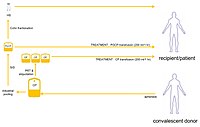
Photo from wikipedia
Convalescent plasma (CP) therapy has been used since the early 1900s to treat emerging infectious diseases; its efficacy was later associated with the evidence that polyclonal neutralizing antibodies can reduce… Click to show full abstract
Convalescent plasma (CP) therapy has been used since the early 1900s to treat emerging infectious diseases; its efficacy was later associated with the evidence that polyclonal neutralizing antibodies can reduce the duration of viremia. Recent large outbreaks of viral diseases for which effective antivirals or vaccines are still lacking has renewed the interest in CP as a life-saving treatment. The ongoing COVID-19 pandemic has led to the scaling up of CP therapy to unprecedented levels. Compared with historical usage, pathogen reduction technologies have now added an extra layer of safety to the use of CP, and new manufacturing approaches are being explored. SUMMARY Convalescent plasma (CP) therapy has been used since the early 1900s to treat emerging infectious diseases; its efficacy was later associated with the evidence that polyclonal neutralizing antibodies can reduce the duration of viremia. Recent large outbreaks of viral diseases for which effective antivirals or vaccines are still lacking has renewed the interest in CP as a life-saving treatment. The ongoing COVID-19 pandemic has led to the scaling up of CP therapy to unprecedented levels. Compared with historical usage, pathogen reduction technologies have now added an extra layer of safety to the use of CP, and new manufacturing approaches are being explored. This review summarizes historical settings of application, with a focus on betacoronaviruses, and surveys current approaches for donor selection and CP collection, pooling technologies, pathogen inactivation systems, and banking of CP. We additionally list the ongoing registered clinical trials for CP throughout the world and discuss the trial results published thus far.
Journal Title: Clinical Microbiology Reviews
Year Published: 2020
Link to full text (if available)
Share on Social Media: Sign Up to like & get
recommendations!